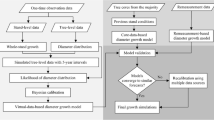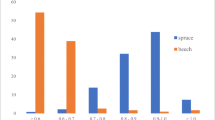Abstract
Diameter distribution models for even-aged Eucalyptus grandis plantations in Zimbabwe were developed using the two-parameter Weibull function. The analysis was based on data from Correlated Curve Trend (CCT) experiments replicated on four different sites. Parameters of the Weibull distribution were predicted using stand characteristics as regressors. Two sets of parameter models were estimated: a set with and one without stand basal area as a predictor. Stand variables such as dominant height, age, site index and number of stems were used in both sets. The models were further calibrated to result in a given number of stems and stand basal area simultaneously. The usability of constructed models was tested both in prediction of yield in a stand inventory situation and in simulation of growth in connection with different growth models. The results indicated that models not including stand basal area produce considerably less precise stand volume estimates compared to models including also stand basal area. Calibration improved the accuracy of diameter distribution models. In growth simulation diameter distribution models can be connected both to single tree growth models and to stand projection models. The usability of calibration in growth simulation depends on the accuracy of the prediction of stand characteristics.
Similar content being viewed by others
References
Alder D. 1979. A distance-independent tree model for exotic conifer plantations in East Africa. Forest Science 25: 59–71.
Bailey R.D. 1980. Individual tree growth derived from diameter distribution models. Forest Science 26: 626–632.
Bailey R.L. and Dell T.R. 1973. Quantifying diameter distributions with the Weibull function. Forest Science 19: 97–104.
Bailey R.L., Abernethy N.C. and Jones E.P. 1981. Diameter distribution models for repeatedly thinned Slash pine plantations. USDA Forest Service General Technical Report SO 34: 115–122.
Bitterlich W. 1984. The Relascope Idea. Commonwealth Agricultural Bureaux. Farnham Royal, 242 pp.
Borders B.E. 1989. Systems of equations in forest stand modeling. Forest Science 35: 548–556.
Borders B.E. and Bailey R.L. 1986. A compatible system of growth and yield equations for slash pine fitted with restricted three-stage least squares. Forest Science 32: 185–201.
Borders B.E., Souter R.A., Bailey R.L. and Ware K.D. 1987. Percentile-based distributions characterize forest stand tables. Forest Science 33: 570–576.
Borders B.E. and Patterson W.D. 1990. Projecting stand tables: A comparison of the Weibull diameter distribution method, a percentile-based projection method, and a basal area growth projection method. Forest Science 36: 413–424.
Brooks J.R., Borders B.E. and Bailey R.L. 1992. Predicting diameter distributions for site-prepared loblolly and slash pine plantations. Southern Journal Applied Forestry 16: 130–133.
Burk T.E. and Newberry J.D. 1984. A simple algorithm for moment-based recovery of Weibull distribution parameters. Forest Science 30: 329–332.
Cao Q.V. and Burkhart H.E. 1984. A segmented approach for modeling diameter frequency data. Forest Science 30: 129–137.
Cao Q.V. and Baldwin V.C. Jr. 1999. A new algorithm for stand table projection models. Forest Science 45: 506–511.
Clutter J.L., Fortson J.C., Pienaar L.V., Brister G.H. and Bailey R.L. 1983. Timber management: A Quantitative Approach. John Wiley and Sons, New York, 333 pp.
Crockford K.L. 1995. Yield models and tables for Pinus patula, Pinus elliottii and Pinus taeda in Zimbabwe. Zimbabwe Bulletin of Forestry Research. No. 12. FRC. Highlands, Harare, 51 pp.
Deville J.C. and Särndal C.E. 1992. Calibration estimators in survey sampling. Journal of the American Statistical Association 87: 376–382.
Forss E., Maltamo M. and Sarämaki J. 1998. Static stand and tree characteristics models for Acacia mangium Willd. plantations. Tropical Forest Science 10: 318–336.
Gove J.H. and Patil G.P. 1998. Modeling basal area-size distribution of forest stands: a compatible approach. Forest Science 44: 285–297.
Hafley W.L. and Schreuder H.T. 1990. Statistical distributions for fitting diameter and height data in even-aged stands. Canadian Journal of Forest Research 4: 481–487.
Hui G.Y. and Gadow K.v. 1996. Ein Neuer Ansatz zu modellierung von Durchmesserverteilungen. Centralblatt für das gesamte Forstwesen 113: 101–113.
Hyink D.M. and Moser J.W. 1983. A generalized framework for projecting forest yield and stand structure using diameter distributions. Forest Science 29: 85–95.
Hynynen J. 1995. Predicting the growth response to thinning for Scots Pine stands using individual-tree growth models. Silva Fennica 29: 225–246.
Kangas A. and Maltamo M. 2000a. Calibrating predicted diameter distribution with additional information. Forest Science 46: 390–396.
Kangas A. and Maltamo M. 2000b. Percentile based basal area diameter distribution models for Scots pine, Norway spruce and birch species. Silva Fennica 34: 371–380.
Kangas A. and Maltamo M. 2000c. Performance of percentile based diameter distribution prediction and weibull method in independent data sets. Silva Fennica 34: 381–398.
Kärki T., Maltamo M. and Eeriläinen K. 2000. Diameter distribution, stem volume and stem quality models for grey alder (Alnus incana) in eastern Finland. New Forests 20: 65–86.
Kilkki P. and Päivinen R. 1986. Weibull function in the estimation of the basal area DBH-distribution. Silva Fennica 20: 149–156.
Knoebel B.R. and Burkhart H.E. 1991. A Bivariate distribution approach to modelling forest diameter distribution at two points in time. Biometrics 47: 241–253.
Knoebel B.R., Burkhart H.E. and Beck D.E. 1986. A growth and yield model for thinned stands of yellow-poplar. Forest Science Monograph 27, 39 pp.
Knowe S.A., Ahrens G.R. and Debell D.S. 1997. Comparison of diameter-distribution-prediction, stand-table-projection, and individual-tree-growth modelling approaches for young red alder plantations. Forest Ecology and Management 98: 49–60.
Kolstöm T. 1992. Dynamics of uneven-aged stands of Norway spruce: a model approach. Metsäntutkimuslaitoksen tiedonantoja 411, 29 pp.
Little S. 1983. Weibull diameter distributions for mixed stands of western conifers. Canadian Journal of Forest Research 13: 85–88.
Loetsch F., Zöhrer F. and Haller K.E. 1973. Forest Inventory 2. BLV. Verlagsgesellschaft, München, 469 pp.
Mabvurira D. and Bgoni W. 1996. The growth and yield of E. grandis at Mtao: 20 year spacing trial results. Zimbabwe Bulletin of Forestry Research No. 13. FRC. Highlands, Harare, 13 pp.
Mabvurira D., Staupendahl K. and Schmidt M. 1998. Modelling diameter distributions for unthinned stands of Pinus kesiya in Zimbabwe. In: Pukkala T. and Eerikäinen K. (eds), Modelling the growth of tree plantations and agroforestry systems in South and East Africa. Tiedonantoja /Joensuun yliopisto, metsätieteellinen tiedekunta 80., pp. 155–172.
Mabvurira D. and Eerikäinen K. Taper and volume Functions for Eucalyptus grandis (Hill) Maiden in Zimbabwe. Journal of Tropical Forest Science (in press).
Mabvurira D. and Miina J. Individual-tree growth and mortality models for Eucalyptus grandis (Hill) Maiden plantations in Zimbabwe. Forest Ecology and Management (in press).
Mabvurira D. and Miina J. 2001. Simultaneous growth and yield models for Eucalyptus grandis (Hill) Maiden plantations in Zimbabwe. The Southern African Forestry Journal 191: 1–8.
Maltamo M. 1997. Comparing basal area diameter distributions estimated by tree species and for the entire growing stock in a mixed stand. Silva Fennica 31: 53–65.
Maltamo M. 1998. Basal area diameter distribution in estimating the quantity and structure of growing stock. Tiedonantoja / Joensuun yliopisto, metsätieteellinen tiedekunta, 43 pp.
Maltamo M. and Kangas A. 1998. Methods based on k-nearest neighbour regression in the estimation of basal area diameter distribution. Canadian Journal of Forest Research. 28: 1107–1115.
Maltamo M. and Eerikäinen K. 2000. Non-parametric growth and yield model for Pinus kesiya in Zambia. In: Pukkala T. and Eerikäinen K. (eds), Establishment and management of tree plantations in Southern and Eastern Africa. Tiedonantoja / Joensuun yliopisto, metsätieteellinen tiedekunta Vol. 120., pp. 81–99.
Maltamo M., Kangas A., Uuttera J., Torniainen T. and Saramäki J. 2000. Comparison of percentile based predicted methods and Weibull distribution in describing diameter distribution of heterogeneous Scots pine stands. Forest Ecology and Management 133: 263–274.
Matney T.G. and Sullivan A.D. 1982. Compatible stand and stock tables for unthinned loblolly pine stands. Forest Science 28: 161–171.
Miina J. and Pukkala T. 2000. Using numerical optimization for specifying individual-tree competition models. Forest Science 46: 277–283.
Murray D.M. and Gadow K.v. 1991. Relationships between the diameter distributions before and after thinning. Forest Science 37: 552–559.
Nanang D.M. 1998. Suitability of the Normal, Log-normal and Weibull distributions for fitting diameter distributions of neem plantations in Northern Ghana. Forest Ecology and Management 103: 1–7.
Nelder J.A. 1962. New kinds of systematic designs for spacing experiments. Biometrics 18: 283–307.
Nepal S.K. and Somers G.L. 1992. A generalized approach to stand table projection. Forest Science 38: 120–133.
Päivinen R. 1980. On the estimation of stem diameter distribution and stand characteristics. Folia Forestalia 442, (In Finnish with English summary) 28 pp.
Pienaar L.V. and Harrison W.M. 1989. Simultaneous growth and yield prediction equations for Pinus elliottii plantations in Zululand. South African Forestry Journal 149: 48–53.
Pukkala T. and Pohjonen V. 1993. Yield of Cupressus lusitanica in Ethiopia. Silva Fennica 27: 195–207.
Pukkala T., Saramäki J. and Mubita O. 1990. Management planning system for tree plantations. A case study for Pinus kesiya in Zambia. Silva Fennica 24: 171–180.
Rennolls K., Geary N. and Rollinson T.J.D. 1985. Characterizing diameter distributions by the use of the Weibull distribution. Forestry 56: 57–66.
Saramäki J. 1992. A growth and yield prediction model of Pinus kesiya (Royle ex Gordon) in Zambia. Acta Forestalia Fenica 230, 68 pp.
Siipilehto J. 1999. Improving the accuracy of predicted basal-area diameter distribution in advanced stands by determining stem number. Silva Fennica 33: 281–301.
Smalley G.W. and Bailey R.L. 1974. Yield tables and stand structure for shortleaf pine plantations in the Tennessee, Alabama and Georgia highlands. USDA Forest Service Research Paper. SO 97.
Tang S., Wang Y., Zhang L. and Meng C.-H. 1997. A distribution-independent approach to predicting stand diameter distribution. Forest Science 4: 491–500.
Author information
Authors and Affiliations
Corresponding author
Rights and permissions
About this article
Cite this article
Mabvurira, D., Maltamo, M. & Kangas, A. Predicting and calibrating diameter distributions of Eucalyptus grandis (Hill) Maiden plantations in Zimbabwe. New Forests 23, 207–223 (2002). https://doi.org/10.1023/A:1020391807554
Issue Date:
DOI: https://doi.org/10.1023/A:1020391807554




